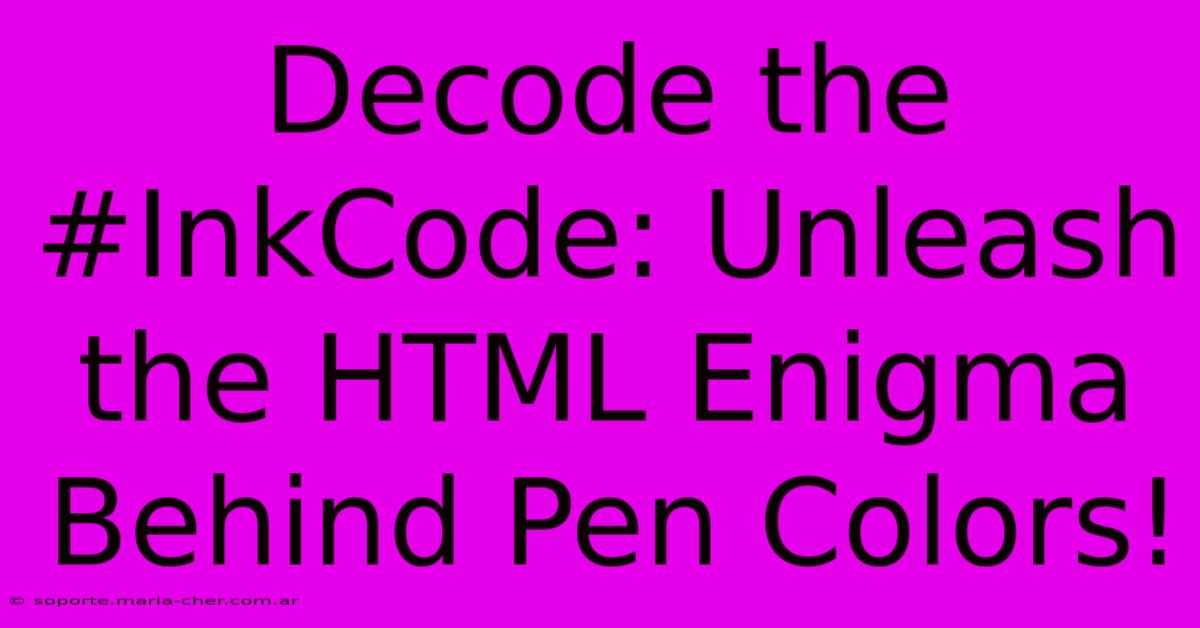Decode The #InkCode: Unleash The HTML Enigma Behind Pen Colors!

Table of Contents
Decode the #InkCode: Unleash the HTML Enigma Behind Pen Colors!
Have you ever wondered how websites magically display vibrant colors, from the deep blues of a corporate logo to the cheerful greens of a nature blog? The secret lies within HTML and its clever use of hexadecimal color codes – the very "ink code" that paints the digital world. This post delves into the fascinating world of HTML color codes, showing you how to decipher them and use them to create visually stunning web pages.
Understanding Hexadecimal Color Codes: The Basics
At its core, a hexadecimal color code is a six-digit alphanumeric code preceded by a hash symbol (#). Each code represents a specific color by combining varying intensities of red, green, and blue (RGB). These three primary colors, when mixed in different proportions, can create virtually any color imaginable.
Decoding the Six Digits:
Each hexadecimal color code is structured as follows: #RRGGBB.
- RR: Represents the intensity of red (00-FF). 00 means no red, and FF means maximum red.
- GG: Represents the intensity of green (00-FF). 00 means no green, and FF means maximum green.
- BB: Represents the intensity of blue (00-FF). 00 means no blue, and FF means maximum blue.
These values use a base-16 numbering system (hexadecimal), where 0-9 represent the numbers 0-9 and A-F represent the numbers 10-15. Therefore, FF represents the highest value (255 in decimal).
Example: #FF0000 represents pure red (maximum red, no green, no blue). #00FF00 represents pure green, and #0000FF represents pure blue.
Beyond the Basics: Exploring Color Variations
The beauty of the hexadecimal system lies in its ability to create millions of color variations. By subtly adjusting the values of red, green, and blue, you can achieve an incredible range of shades and hues.
Creating Lighter and Darker Shades:
To create a lighter shade of a color, increase the values of R, G, and B. To create a darker shade, decrease them. For instance, to make #FF0000 (red) lighter, you could try #FF5050 or #FFAAAA.
Exploring Color Palettes:
Numerous websites and tools are available online to help you explore different color palettes and generate hexadecimal color codes. These tools often allow you to specify a base color and generate harmonious shades for a cohesive design. Experimenting with these tools can significantly enhance your web design skills.
Implementing Hexadecimal Codes in HTML:
Integrating these color codes into your HTML is incredibly straightforward. You can use them with various HTML elements and attributes, such as:
styleattribute: Directly within an HTML element's style attribute, like<p style="color: #0000FF;">This text is blue.</p>.- CSS stylesheets: For a cleaner, more organized approach, define colors in your CSS stylesheet and reference them by class or ID.
Boosting Your Website's Visual Appeal:
Mastering hexadecimal color codes empowers you to create visually appealing and engaging websites. Consistent use of a well-defined color palette can strengthen your brand identity and improve user experience.
Tips for Effective Color Use:
- Consider your target audience: Different colors evoke different emotions.
- Ensure sufficient contrast: Ensure readability by choosing colors with enough contrast between text and background.
- Use color psychology: Understand how different colors affect your audience's perception.
- Test across devices: Check your website's appearance across different browsers and devices.
By understanding and utilizing HTML's hexadecimal color system, you are not just adding color to your website – you are crafting a visual experience that captivates and engages your visitors. So, unleash your inner artist and start exploring the endless possibilities of the "#InkCode"!

Thank you for visiting our website wich cover about Decode The #InkCode: Unleash The HTML Enigma Behind Pen Colors!. We hope the information provided has been useful to you. Feel free to contact us if you have any questions or need further assistance. See you next time and dont miss to bookmark.
Featured Posts
-
New Aga Khan Named Leader
Feb 06, 2025
-
Unlocking Blast Resistance For Embassies The Miracle Of Polyurea
Feb 06, 2025
-
The Appliance That Inspires Unleash Your Inner Chef With The Retro Magic Of Big Chill
Feb 06, 2025
-
Workdays Ai Push 1750 Job Cuts
Feb 06, 2025
-
Embrace The Vitality Of Orange Roses A Vibrant Expression Of Health Happiness And Well Being
Feb 06, 2025
